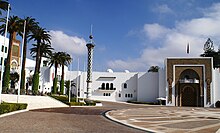Tetouan
| Tetouan تطوان ⵜⵉⵟⵟⴰⵡⵉⵏ |
||||
|---|---|---|---|---|
|
||||
| Basic data | ||||
| State : |
|
|||
| Region : | Tangier-Tétouan-Al Hoceïma | |||
| Province : | Tetouan | |||
| Coordinates | 35 ° 34 ′ N , 5 ° 22 ′ W | |||
| Residents : | 380,787 (2014) | |||
| Area : | 60.9 km² | |||
| Population density : | 6,253 inhabitants per km² | |||
| Height : | 90 m | |||
| Postal code : | 93022 | |||
| City administration website : | ||||
| Tétouan - city view | ||||
Tetouan (from the mazirischen ⵜⵉⵟⵟⴰⵡⵉⵏ Tiṭṭawin , "eyes", Arabic تطوان, DMG Tiṭwān , Spanish Tetuán ) is a historically important city not far from the Mediterranean coast of Morocco with about 400,000 inhabitants. Since 1997 the old town (medina) has been recognized as a World Heritage Site by UNESCO . Since 1999 it has been the summer residence of King Mohammed VI because of its moderate climate .
The Berber name of the city literally means "eyes". It also has the poetic nickname "The White Dove" ( French La Colombe blanche ).
Location and climate
The city of Tétouan, which is rainy by Moroccan standards, is located in the northern foothills of the Rif Mountains at an altitude of about 35 to 150 m on a plateau that borders the Jbel Dersa . The city to the north of the Oued Martil is only about 10 km (as the crow flies) from the Mediterranean coast; the Spanish exclave of Ceuta is about 40 km north. The climate is temperate; the rain, which is abundant for Moroccan conditions (approx. 685 mm / year), falls almost exclusively in the winter months.
population
| year | 1994 | 2004 | 2014 |
| Residents | 277,516 | 320,539 | 380,787 |
The rapidly growing population consists mainly of immigrant Rif- Berbers and Arabs, but the cultures have largely mixed. Moroccan Arabic and Tarifit are spoken .
economy
The city's inhabitants live mainly from handicrafts, trade, services and tourism. Fish processing and the pumping of North Sea shrimp play an important role. The textile, cigarette and electronics industries offer further sources of income.
history
In contrast to other cities on the Mediterranean coast, there is no evidence of any evidence from the Phoenician period for Tetouan. The Romans founded a military settlement called Oppidum Tamuda near today's city . In the 14th century Tétouan was feared as a pirate's nest and was therefore repeatedly attacked by Castilian ships. After the conquest of Granada (1492) and again at the beginning of the 17th century, Moorish and Jewish refugees from Andalusia settled, which resulted in an economic boom in the city.
As part of the Spanish-Moroccan War , several small but very bloody skirmishes between Spaniards and Moroccans took place near Tétouan, after which the Spaniards occupied the city on February 4, 1860. After a decisive defeat west of Tétouan on March 23, the Moroccans asked for a ceasefire.
As early as the end of the 19th century - after the loss of its overseas colonies - Spain became increasingly active in northern Morocco and in 1913 Tétouan became the residence of the Spanish High Commissioner in Morocco. In Spanish Morocco , the military coup began on July 17, 1936 to overthrow the Spanish government , with the military in Tétouan being loyal to the Spanish government. After taking Tetouan and the Sania Ramel Air Force Base, the coup plotters liquidated the High Commissioner of Spanish Morocco and Major Ricardo de la Puente Bahamonde along with 189 other Republicans. During the Spanish Civil War , Tétouan was bombed by aircraft from the Republican side. In 1956 Franco gave in to international pressure and agreed to Morocco's independence.
Attractions
- The main attraction of Tétouan is the extensive medina , a UNESCO World Heritage Site, with its close juxtaposition of living, handicrafts and trade.
- The archeological museum ( Musée d'archéologie ) is well worth seeing and is located at the transition to the new town (ville nouvelle) and shows prehistoric finds as well as a beautiful collection of Roman mosaics, coins and ceramics; In the garden area there are a large number of gravestones - Libyan-Berber, Roman, Islamic, Jewish and Portuguese in peaceful coexistence.
- Another museum ( Musée d'ethnographie ) is at the opposite end of the medina near the tanners' district.
- The Center d'art moderne de Tétouan , which opened in 2014 in the former station building, is located near the medina.
- The buildings from the Spanish colonial era - especially the parish church of Nuestra Señora de la Victoria on Place Moulay el Mehdi , built in neo-Moorish style - are also worth seeing.
- Surroundings
- The ruins of the Roman oppidum Tamuda , a military settlement with a square floor plan, located about 5 km from the city center , are worth a short visit.
sons and daughters of the town
- Abdessadak Chkara (1931–1998), musician
- Lolo Sainz (* 1940), Spanish basketball player and coach
- Ali Lmrabet (* 1959), journalist
- Adel Mechaal (* 1990), Spanish-Moroccan middle-distance runner
Town twinning
-
 Santa Fe , Argentina
Santa Fe , Argentina
Others
In 2015, the International Astronomical Union (IAU) named the double star Titawin after the city.
literature
- Arnold Betten: Morocco. Antiquity, Berber Traditions and Islam - History, Art and Culture in the Maghreb. DuMont, Ostfildern 2012, pp. 138f, ISBN 978-3-7701-3935-4 .
Web links
- Tétouan ( Memento from January 12, 2013 in the web archive archive.today )
Individual evidence
- ↑ Entry on the website of the UNESCO World Heritage Center ( English and French ).
- ↑ Tétouan - climate tables
- ↑ Tétouan - population development etc.
- ^ Antony Beevor, The Spanish Civil War , 2nd edition, ISBN 978-3-442-15492-0 , page 82.







